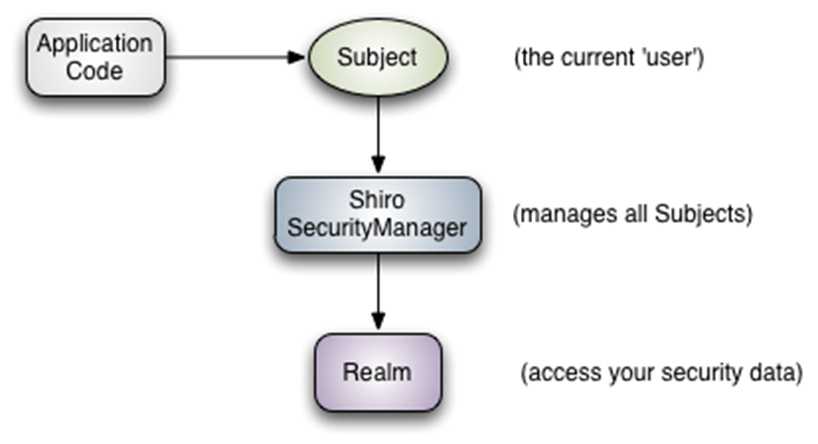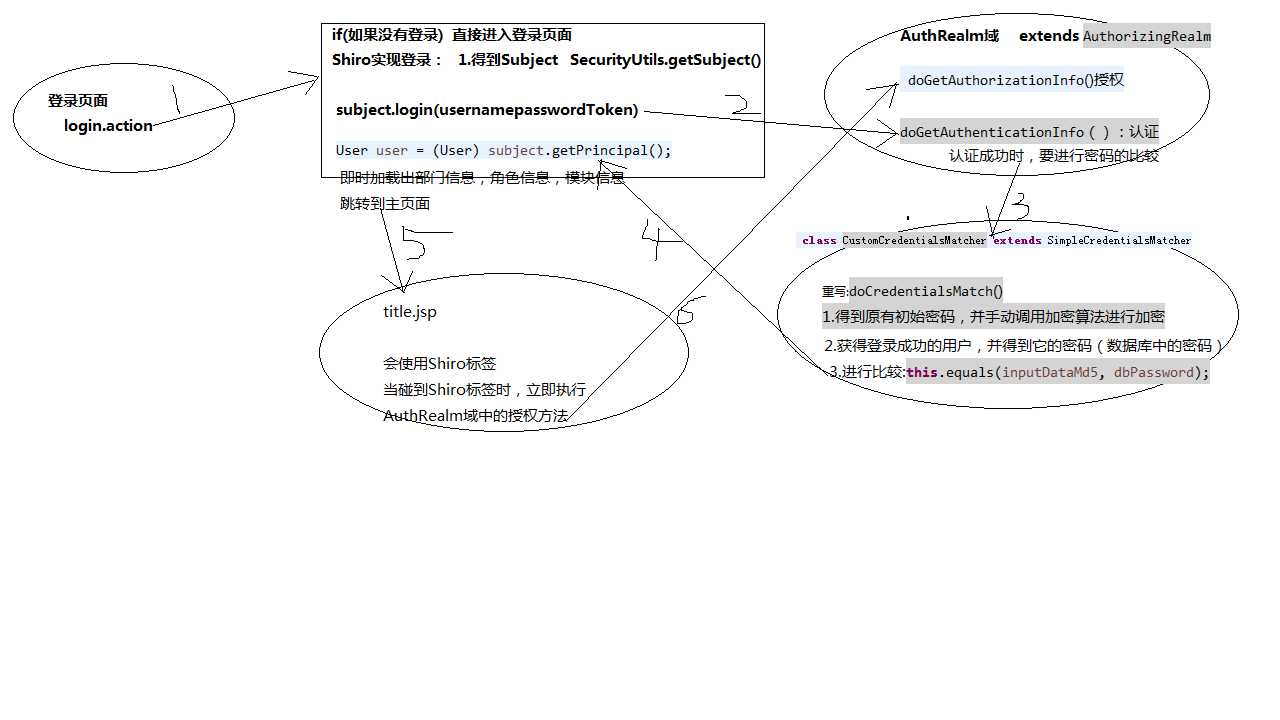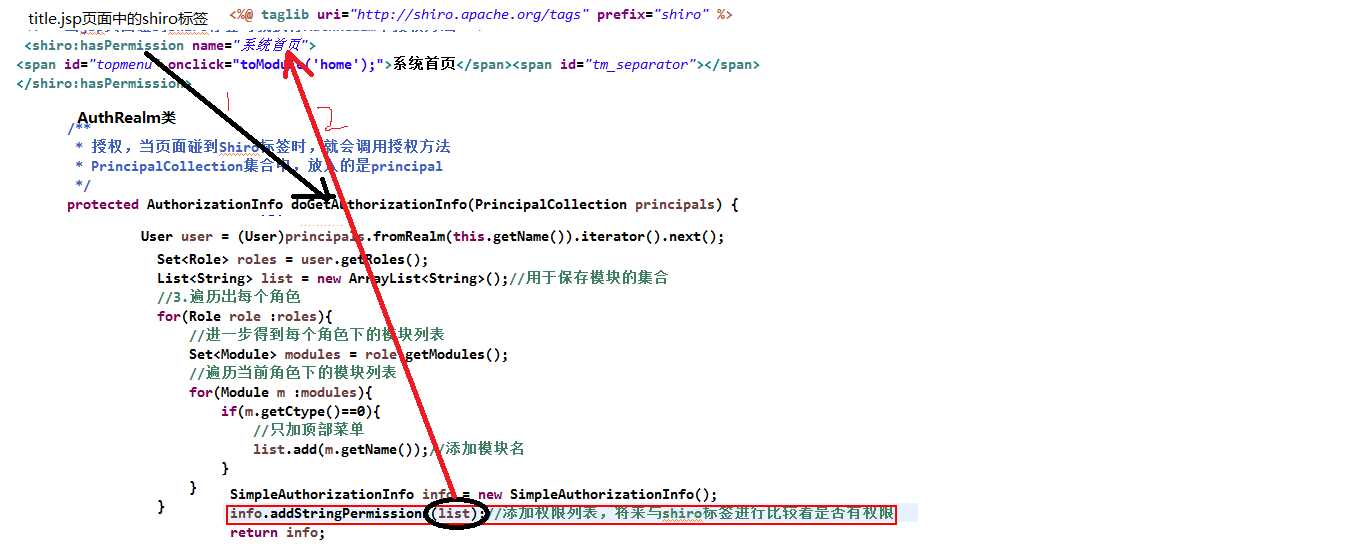标签:get tty 自定义 部门 end 会话管理 目录 角色 ssh
应用:
认证 授权 加密 会话管理(单点登录) 缓存 与web集成

Subject:主体,代表了当前“用户”,这个用户不一定是一个具体的人,与当前应用交互的任何东西都是Subject,如网络爬虫,机器人等;即一个抽象概念;所有Subject都绑定到SecurityManager,与Subject的所有交互都会委托给SecurityManager;可以把Subject认为是一个门面;SecurityManager才是实际的执行者;
SecurityManager:安全管理器;即所有与安全有关的操作都会与SecurityManager交互;且它管理着所有Subject;可以看出它是Shiro的核心,它负责与后边介绍的其他组件进行交互,如果学习过SpringMVC,你可以把它看成DispatcherServlet前端控制器;
Realm:域,Shiro从Realm获取安全数据(如用户、角色、权限),就是说SecurityManager要验证用户身份,那么它需要从Realm获取相应的用户进行比较以确定用户身份是否合法;也需要从Realm得到用户相应的角色/权限进行验证用户是否能进行操作;可以把Realm看成DataSource,即安全数据源
使用步骤:
过滤器的配置:
共有10个过滤器 但是实际使用的时候只要配置一个核心过滤器就行了。
<!--注意:如果是和struts2整合的话,shiro的filter必须在struts2的filter之前,否则action无法创建--> <filter> <filter-name>shiroFilter</filter-name> <filter-class>org.springframework.web.filter.DelegatingFilterProxy</filter-class> <init-param> <param-name>targetFilterLifecycle</param-name> <param-value>true</param-value> </init-param> </filter> <filter-mapping> <filter-name>shiroFilter</filter-name> <url-pattern>/*</url-pattern> </filter-mapping>
过滤器种类:

产生代理类的方式:
<!--放在applicationContext.xml事务管理器声明前-->
<!--产生Shiro控制器的方式 使用cglib生成代理-->
<aop:aspectj-autoproxy proxy-target-class="true" />
applicationContext-shiro.xml(web层):
<?xml version="1.0" encoding="UTF-8"?> <beans xmlns="http://www.springframework.org/schema/beans" xmlns:xsi="http://www.w3.org/2001/XMLSchema-instance" xmlns:p="http://www.springframework.org/schema/p" xmlns:context="http://www.springframework.org/schema/context" xmlns:tx="http://www.springframework.org/schema/tx" xmlns:aop="http://www.springframework.org/schema/aop" xsi:schemaLocation="http://www.springframework.org/schema/beans http://www.springframework.org/schema/beans/spring-beans.xsd http://www.springframework.org/schema/aop http://www.springframework.org/schema/aop/spring-aop.xsd http://www.springframework.org/schema/tx http://www.springframework.org/schema/tx/spring-tx.xsd http://www.springframework.org/schema/context http://www.springframework.org/schema/context/spring-context.xsd"> <description>Shiro与spring整合的配置文件(天然整合)</description> <!-- SecurityManager配置 --> <!-- 配置Realm域 --> <!-- 密码比较器 --> <!-- 代理如何生成? 用工厂来生成Shiro的相关过滤器 --> <!-- 配置缓存:ehcache缓存 --> <!-- 安全管理 --> <bean id="securityManager" class="org.apache.shiro.web.mgt.DefaultWebSecurityManager"> 2<property name="realm" ref="authRealm" /><!-- 引用自定义的realm --> <!-- 二级缓存 --> <property name="cacheManager" ref="shiroEhcacheManager" /> </bean> <!-- 自定义权限认证 --> <bean id="authRealm" class="com.zixue.shiro.AuthRealm"> <!-- class由程序员定义 --> <property name="userService" ref="userService" /> <!-- 自定义密码加密算法 --> <property name="credentialsMatcher" ref="passwordMatcher" /> <!-- ref由程序员定义 --> </bean> <!-- 设置密码加密策略 md5hash --> <bean id="passwordMatcher" class="com.zixue.shiro.CustomCredentialsMatcher" /> <!-- class由程序员定义 --> <!-- filter-name这个名字的值来自于web.xml中filter的名字 --> <bean id="shiroFilter" class="org.apache.shiro.spring.web.ShiroFilterFactoryBean"><!--这个才是生产过滤器的根源 web.xml的DelegatingFilterProxy并不能直接生成--> <property name="securityManager" ref="securityManager" /> <!--登录页面 --> <!--接收loginAction中的subject.login(token)方法,调用了Realm域中的认证方法(反射来实现调用)--> <property name="loginUrl" value="/index.jsp"></property> <!-- 登录成功后 --> <property name="successUrl" value="/home.action"></property> <property name="filterChainDefinitions"> <!-- /**代表下面的多级目录也过滤 --> <value> /index.jsp* = anon <!-- (过滤器名) --> /home* = anon /sysadmin/login/login.jsp* = anon /sysadmin/login/logout.jsp* = anon /login* = anon /logout* = anon /components/** = anon /css/** = anon /images/** = anon /js/** = anon /make/** = anon /skin/** = anon /stat/** = anon /ufiles/** = anon /validator/** = anon /resource/** = anon /** = authc <!--根目录下所有资源及子目录 --> /*.* = authc <!-- 本目录所有资源 --> </value> </property> </bean> <!-- 用户授权/认证信息Cache, 采用EhCache 缓存 --> <bean id="shiroEhcacheManager" class="org.apache.shiro.cache.ehcache.EhCacheManager"> <property name="cacheManagerConfigFile" value="classpath:ehcache-shiro.xml" /> <!-- 引入ehcache-shiro.xml --> </bean> <!-- 保证实现了Shiro内部lifecycle函数的bean执行 --> <bean id="lifecycleBeanPostProcessor" class="org.apache.shiro.spring.LifecycleBeanPostProcessor" /> <!-- 生成代理,通过代理进行控制 --> <bean class="org.springframework.aop.framework.autoproxy.DefaultAdvisorAutoProxyCreator" depends-on="lifecycleBeanPostProcessor"> <property name="proxyTargetClass" value="true" /> </bean> <!-- 安全管理器 --> <bean class="org.apache.shiro.spring.security.interceptor.AuthorizationAttributeSourceAdvisor"> <property name="securityManager" ref="securityManager" /> </bean> </beans>
在applicationContext.xml文件中加载shiro配置文件:
<import resource="classpath:spring/applicationContext-shiro.xml"></import>
ehcache-shiro.xml 缓存(和applicationContext.xml一起)
<?xml version="1.0" encoding="UTF-8"?> <ehcache updateCheck="false" name="shiroCache"> <defaultCache maxElementsInMemory="10000" eternal="false" timeToIdleSeconds="120" timeToLiveSeconds="120" overflowToDisk="false" diskPersistent="false" diskExpiryThreadIntervalSeconds="120"/> </ehcache>
编写密码比较器:
1.Encrypt.java(使用Md5Hash算法 放在工具包下)
public class Encrypt { /* * 散列算法一般用于生成数据的摘要信息,是一种不可逆的算法,一般适合存储密码之类的数据, * 常见的散列算法如MD5、SHA等。一般进行散列时最好提供一个salt(盐),比如加密密码“admin”, * 产生的散列值是“21232f297a57a5a743894a0e4a801fc3”, * 可以到一些md5解密网站很容易的通过散列值得到密码“admin”, * 即如果直接对密码进行散列相对来说破解更容易,此时我们可以加一些只有系统知道的干扰数据, * 如用户名和ID(即盐);这样散列的对象是“密码+用户名+ID”,这样生成的散列值相对来说更难破解。 */ //高强度加密算法,不可逆 public static String md5(String password, String salt){ return new Md5Hash(password,salt,2).toString(); } public static void main(String[] args) { System.out.println(new Md5Hash("123456","tony",2).toString()); } }
2.密码比较器 CustomCredentialsMatcher.java(和web并级的shiro包下)
public class CustomCredentialsMatcher extends SimpleCredentialsMatcher { /** * 提供一个专门用于进行密码比较的方法 * token:代表用户在界面输入的用户名密码 * AuthenticationInfo info: 代表数据库中的用户信息 * * Md5Hash算法 * 将用户在界面上输入的明文-----------------加密成密文 * 将用户在数据库中的密文获取出来---------------跟用户输入的明文加密后的结果进行比较------------如果相同证明密码也正确,此时返回值就是true * * 返回值: true代表密码比较成功 * false代表密码比较失败,此时程序也会报出异常 */ public boolean doCredentialsMatch(AuthenticationToken token, AuthenticationInfo info) { //1.向下转型 UsernamePasswordToken upToken = (UsernamePasswordToken) token; //2.将用户输入的原始密码进行加密 Md5Hash的参数说明:第一个参数是明文 第二个参数:代表盐 第三个参数:迭代次数 //new Md5Hash(new String(upToken.getPassword()),upToken.getUsername(),2); String encryptPwd = Encrypt.md5(new String(upToken.getPassword()), upToken.getUsername()); //3.跟数据库串密文进行比较 String pwd = info.getCredentials().toString(); //return encryptPwd.equals(pwd); return super.equals(pwd, encryptPwd); } }
配置(applicationContext-shiro.xml已配好 记得修改路径):
//设置密码加密策略 md5hash <bean id="passwordMatcher" class="com.zixue.shiro.CustomCredentialsMatcher">
编写自定义Realm域:
作用:
1.调用业务层和CustomCredentialsMatcher密码比较器(所以需要注入属性)
2.进行认证和授权操作
AuthRealm.java(和web并级的shiro包下):
public class AuthRealm extends AuthorizingRealm { private UserService userService; public void setUserService(UserService userService) { this.userService = userService; } /** * 认证 (登录) * AuthenticationInfo 返回值:代表用户的认证信息 * 如果返回值不为null,说明用户名正确,程序就会继续定位到密码比较器,进行密码的比较 * 如果返回值为null,程序就会抛出异常 */ protected AuthenticationInfo doGetAuthenticationInfo(AuthenticationToken token) throws AuthenticationException { //向下转型 UsernamePasswordToken upToken = (UsernamePasswordToken) token; //1.调用业务方法,实现根据用户名查询 List<User> userList = userService.find("from User where userName=?", User.class, new String[]{upToken.getUsername()}); //2.如果用户存在,就一步验证密码是否正确 if(userList!=null && userList.size()>0){ User user = userList.get(0);//取出查询的用户对象 //用户名正确了 第一个参数:用户对象 第二个参数:代表用户的密码 第三个参数:realm的名字,只要是一个字符串就可以 return new SimpleAuthenticationInfo(user,user.getPassword(),this.getName());//返回密码比较器的类(进入我们注入的密码比较器的对象) } //3.返回结果 return null; } /** * 授权---------------在jsp页面碰到shiro标签时,就要执行授权方法 */ protected AuthorizationInfo doGetAuthorizationInfo(PrincipalCollection pc) { //1.获取当前登录的用户信息 User user = (User)pc.fromRealm(this.getName()).iterator().next(); //2.通过对象导航,得到角色列表 Set<Role> roleSet = user.getRoles(); List<String> moduleList = new ArrayList<String>(); //3.遍历角色列表,得到每个角色 for (Role role : roleSet) { //通过对象导航,得到角色下面的模块列表 Set<Module> moduleSet = role.getModules(); for (Module module : moduleSet) { if(!moduleList.contains(module.getName())){ moduleList.add(module.getName()); } } } //设置返回值 SimpleAuthorizationInfo info = new SimpleAuthorizationInfo(); info.addStringPermissions(moduleList); return info; } }
将编写的AuthRealm域配置好(applicationContext-shiro.xml已配好 记得修改路径):
//自定义权限认证 <bean id="autoRealm" class="com.zixue.shiro.AuthRealm"> <property name="userService" ref="userService"/> //自定义密码加密算法 <propetty name="credentialsMatcher" ref="passwordMatcher"> </bean>
登陆操作:
loginAction
作用:应用程序与Shiro框架进行交互的Subject对象获取
public class LoginAction extends BaseAction { private static final long serialVersionUID = 1L; private String username; private String password; //SSH传统登录方式 public String login() throws Exception { // if(true){ // String msg = "登录错误,请重新填写用户名密码!"; // this.addActionError(msg); // throw new Exception(msg); // } // User user = new User(username, password); // User login = userService.login(user); // if (login != null) { // ActionContext.getContext().getValueStack().push(user); // session.put(SysConstant.CURRENT_USER_INFO, login); //记录session // return SUCCESS; // } // return "login"; if(UtilFuns.isEmpty(username)){ return "login"; } try { //1.应用程序与Shiro框架进行交互的Subject对象如何获取 ? Subject subject = SecurityUtils.getSubject(); //2.AuthenicationToken是接口 所以只能new子类的对象 AuthenticationToken token = new UsernamePasswordToken(username, password); //3.实现登录操作 subject.login(token);//进入AuthRealm类中的方法doGetAuthenticationInfo //4.从Shiro中获取登录的用户信息 User user = (User)subject.getPrincipal(); //5.将用户信息存入session中 session.put(SysConstant.CURRENT_USER_INFO, user); } catch (Exception e) { e.printStackTrace(); request.put("errorInfo", "用户名或密码错误!!"); return "login"; } return SUCCESS; } //退出 public String logout(){ session.remove(SysConstant.CURRENT_USER_INFO); //删除session SecurityUtils.getSubject().logout(); //登出 return "logout"; } public String getUsername() { return username; } public void setUsername(String username) { this.username = username; } public String getPassword() { return password; } public void setPassword(String password) { this.password = password; } }
测试:
当jsp页面上出现Shiro标签就会执行AuthRealm域中的授权方法
1.引入Shiro标签
<%@taglib uri="http:shiro.apache.org/tags" prefix="shiro" %>
2.使用Shiro标签进行授权判断
<shiro:hasPermission name="货运管理"><span id="topmenu" onclick="toModule(‘cargo‘);">货运管理</span><span id="tm_separator"></span></shiro:hasPermission>

Shiro运行流程分析:

登陆流程:

授权流程:

关于进入自己账户后直接在地址栏输入权限不同的其他用户地址,依旧可以进入的
BUG解决:
使用perms过滤器进行权限拦截
1.配置 /sysadmin/deptAction_* = perms["部门管理"] 2.方法加入注解 @RequiresPermissions("部门管理") 3.加入配置 <property name="unauthorizedUrl" value="/index.jsp"></property>
标签:get tty 自定义 部门 end 会话管理 目录 角色 ssh
原文地址:https://www.cnblogs.com/kz2017/p/8932992.html